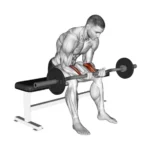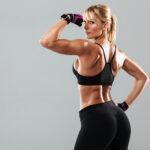Leg Press: Exercise Overview
The leg press is a versatile machine-based exercise designed to target the major muscle groups of the legs, primarily the quadriceps, with the ability to also engage the hamstrings and glutes depending on foot placement. As a controlled alternative to the barbell squat, it isolates the lower body while reducing the demand on stabilizing muscles, making it an effective accessory movement or primary exercise in gyms lacking squat racks.
While similar to the squat, the leg press does not fully replicate its movement pattern or engage the same range of muscles, such as the core and back (Escamilla et al., 2001). It’s ideal for building lower-body strength and size and can be incorporated into leg workouts, lower-body sessions, or full-body routines, supporting both aesthetic and functional fitness goals (Schoenfeld, 2010).
How to Perform the Leg Press
- Load the leg press machine with an appropriate weight and sit in the seat, ensuring your back is flat against the pad.
- Place your feet shoulder-width apart on the sled, adjusting toe angle based on comfort and mobility—this is your starting position.
- Inhale deeply, extend your legs to push the sled away, and release the safety locks.
- Lower the sled with control by bending your knees until they form roughly a 45-degree angle or slightly deeper, depending on your range of motion.
- Push through your feet to extend your knees and return the sled to the starting position, stopping just short of full lockout.
- Repeat for the desired number of repetitions.
Tips for Optimal Performance
- Adjust Foot Placement: Push through the balls of your feet to emphasize the quads or through your heels to target the glutes and hamstrings more effectively (Escamilla et al., 2001).
- Maintain Tension: Avoid fully locking out your knees at the top to keep constant tension on the target muscles, enhancing activation (Schoenfeld, 2016).
- Keep a Neutral Spine: Press your lower back firmly against the pad to prevent posterior pelvic tilt and reduce strain on the spine (McGill, 2010).
- Control the Movement: Lower and push the sled slowly to maximize muscle engagement and minimize momentum, reducing injury risk.
- Adjust Toe Angle: Experiment with toe angles (neutral, slightly in, or out) based on your hip anatomy and ankle mobility to find the most comfortable position (Wirth et al., 2016).
- Breathe Properly: Inhale as you lower the sled and exhale as you push it back up to support core stability and muscle oxygenation.
- Use Hands for Safety: If needed, lightly press your hands against your knees to assist in controlling the sled, especially during heavier sets.
Powering up your quads with leg presses? Dive into our Ultimate Guide to Muscle Groups for a full leg training plan.







